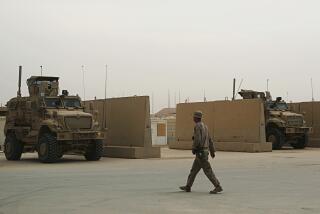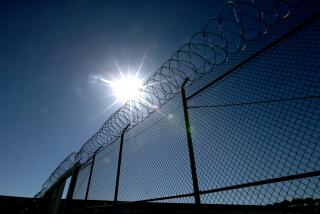Bases Will Likely Take Less of a Hit
WASHINGTON — Defense Secretary Donald H. Rumsfeld indicated Tuesday that this year’s round of military base closings may not be as drastic as earlier forecasts had suggested, but stressed that closing down installations was “a good thing” that saved taxpayer money.
Only weeks away from a Pentagon proposal for shutdowns, Rumsfeld said that fewer than 20% of base facilities in the United States were likely to be mothballed this year. That prediction contrasted with a Pentagon report to Congress earlier this year that said 24% of domestic bases were not needed.
Rumsfeld said the transfer of thousands of U.S. troops from bases around the world would reduce the effect on U.S. facilities.
“The fact that we’re bringing so many forces home from overseas reduces that number,” Rumsfeld told reporters at the Pentagon.
Rumsfeld had earlier repeatedly cited a Clinton administration estimate that 20% to 25% of the capacity of more than 400 U.S. bases should be cut, but said Tuesday that the eventual number would be “less than the lower end of that range -- how much less remains to be seen.”
He provided no hint of which bases faced closure. California officials have mobilized to counter further cuts in the state after losing 24 bases in previous closures. This year, Gov. Arnold Schwarzenegger appointed a bipartisan council to protect military installations, which are considered to be worth $40 billion to the state’s economy.
Because it is such a politically volatile process nationwide, Congress set up a complex procedure by which the Pentagon must submit its recommendations by May 16 to the presidentially appointed Base Realignment and Closure Commission. After the commission devises its recommendations, it reports to the president in September. Bush can approve the list or send it back to the commission, which must resubmit it in October. In November, the base closings are submitted to Congress.
The president and Congress must approve or disapprove the recommendations in their entirety.
Bush named the base-closing commission March 15. There are two Californians on the nine-member panel, including its chairman, Anthony J. Principi, who was Bush’s former Veterans Affairs secretary. The other is Philip Coyle, a Los Angeles resident and a former assistant Defense secretary.
Before being named to the base closing panel, Coyle served on the California Council on Base Support and Retention, the panel set up to protect California bases.
In March 2004, Pentagon officials told Congress that 24% of the nation’s base structure was “excess,” accounting for $7 billion in annual costs. Even reduced, the estimated cuts will be significant, analysts said.
“I would still draw from his comments the inference that this is going to be by far the biggest round of base closures ever attempted,” said Loren Thompson, a military analyst at the Lexington Institute, an Arlington, Va., public policy group.
Caught unprepared in the first round of closings in 1988, California lost more than 20 installations, including the El Toro Marine base in Orange County, the Long Beach Naval Shipyard, the Presidio of San Francisco and Ft. Ord near Monterey.
Even at slightly less than 20%, the 2005 round of closures is likely to eclipse those in 1988, 1991 and 1993, as well as a massive round in 1995 that included the closure of the Sacramento and San Antonio Air Force repair centers, analysts said.
Rumsfeld is still reviewing the recommendations of his internal base closure analysis team as states deploy lobbyists on behalf of their bases.
Rumsfeld said Tuesday that he had not responded to lobbying efforts, adding, “I haven’t met with a single governor” in connection with the base-closing commission.
The state council’s goal is to retain as many as possible of California’s 62 remaining California military installations. The state has set aside about $500,000 this year toward the campaign.
Because the Pentagon increasingly seeks to combine various operations at one site to save money, massive bases such as Camp Pendleton and Edwards Air Force Base are less likely to see major cuts.
However, local hosts of military bases perceive grave risks.
“The stakes are high for California,” said Jon McQuiston, a former Navy air traffic controller and a supervisor in Kern County, home to the China Lake Naval Air Weapons Station and parts of Edwards. “I feel DOD needs those resources as much as the state of California and Kern County need the bases for economic development.”
It helps that California has a Republican governor who is active in the process, McQuiston said.
“California should fare OK” if there is a fair base-closing commission process, he said, adding: “But at the end of the day, there’s going to be a lot of political influences.”
Schwarzenegger spokesman Vince Sollitto said the heavy toll of past closings wouldn’t result in a break for California in 2005 because decisions would be based solely on strategic needs.
“The good news for California is that our state has many bases that are well-situated and well-suited to the military’s mission in the future,” Sollitto said. “Therefore, competing on the merits will be a good thing for California.”
Although communities consider base closure a painful and potentially devastating process, Rumsfeld said in the larger picture it would improve accountability to taxpayers.
The base-closing process “is a good thing,” Rumsfeld said. “It says to the taxpayers of America, ‘By golly, we care about your dollars, and we’re going to see that the dollars are spent in an intelligent way on things that are actually needed, rather than wasted funds.’ ”
More to Read
Get the L.A. Times Politics newsletter
Deeply reported insights into legislation, politics and policy from Sacramento, Washington and beyond. In your inbox three times per week.
You may occasionally receive promotional content from the Los Angeles Times.










